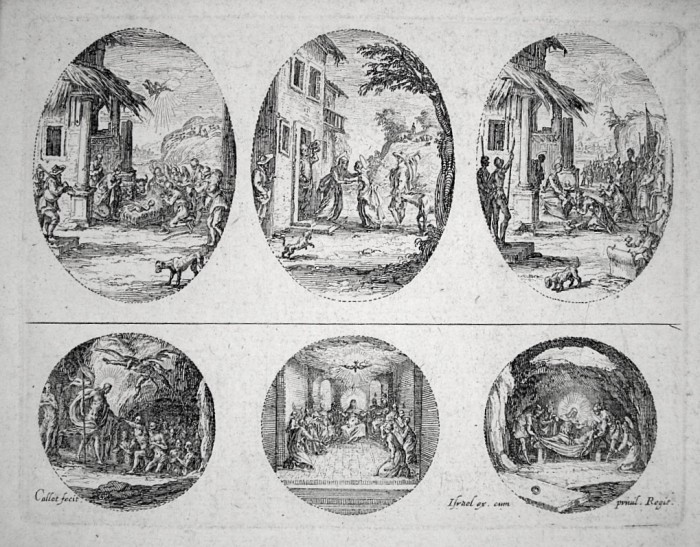Mysteries of the Passion (Variae Tum Passionis Christi)

Jacques Callot (1592-1635), Mysteries of the Passion (Variae Tum Passionis Christi, Tum Vitiae Beatae Mariae Virginis), complete set of 20 etchings plus the frontispiece by Abraham Bosse (Reference Meaume 31). c. 1631. Reference: Lieure 679-698, second state (of 2). In very good condition, archival mounting.
A fine set of these small etchings, printed on 5 plates/sheets of laid paper, with margins, 3 of the plates with partial Crown watermarks (possibly Lieure 45).
The set of 20 etchings includes 7 in circular format, with a diameter of 1 1/4 inches; 7 larger ovals with a length of 1 7/8 inches, and 6 smaller ovals with a length of 1 1/2 inches. These are on 5 plates, with margins outside of the etchings of about 5/8 inches. The frontispiece is 3 1/2 x 3, the sheet 4 1/2 x 4 3/4 inches.
The 20 etchings of the series include:
Plate with 6 Scenes (Lieure 685-690): Ovals: Adoration of the Shepherds, Visitation, Adoration of the Magi; Circles: Descent into Limbo, Descent of the Holy Spirit, Entombment
2 Plate with 4 Scenes Each (Lieure 691-698): Ovals: Annunciation, Christ Among Teachers, Circumcision, Presentation; Circles: Resurrection, Crucifixion, Descent from the Cross, Transfiguration
2 Plates with 3 Oval Scenes Each (Lieure 679-684): Carrying of the Cross, Presentation to the People, Crowning with Thorns, Flagellation, Christ Before Pilate, Christ Delivered to the Jews.
These tiny etchings were originally made on 3 plates; later Israel Henriet cut two of the plates in half, issuing the set with the additional frontispiece made by Bosse, adding his “excudit” and Callot’s name to each plate.
The etchings were designed to be cut out and mounted as medallions to be worn around the neck as protection against the Black Plague, which was ravaging the Lorraine area in 1631. The details are so small that they are best seen under a magnifying glass (or perhaps by vulnerable microbes). As in all the best Callot prints, the compositions would appear to “work” even in formats many times their size.
Six of the 20 plates are illustrated; additional illustrations are of course available on request.